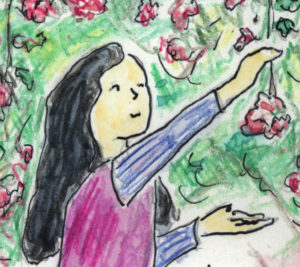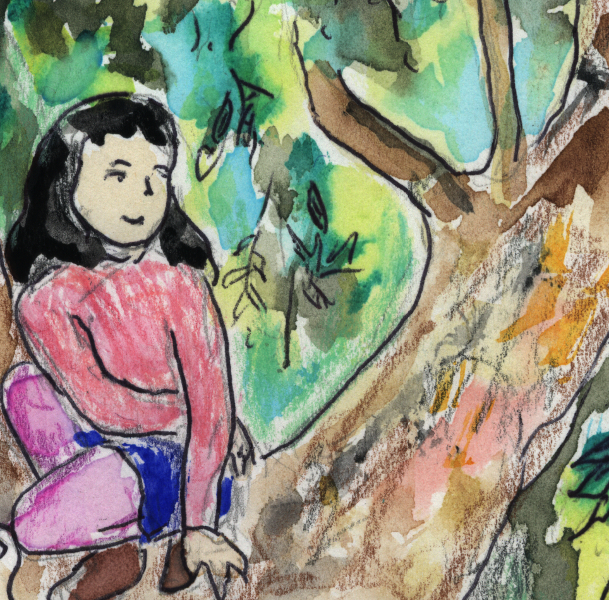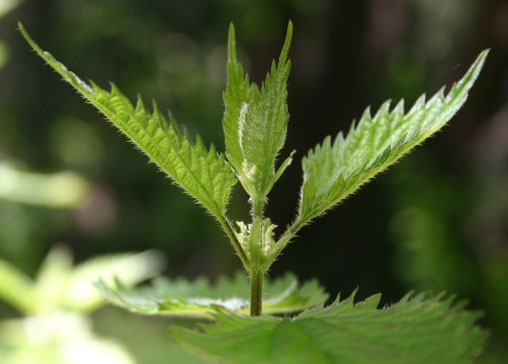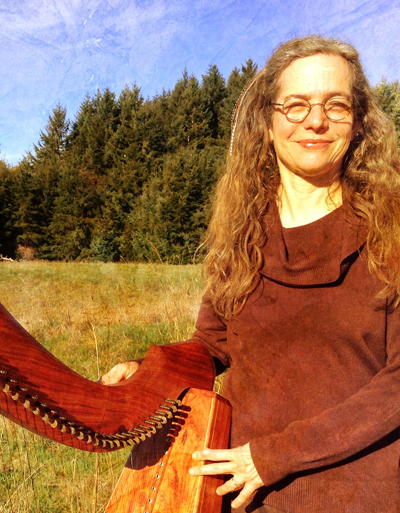
DIVING IN THE MOON
HONORING STORY, FACILITATING HEALING
© Jane Valencia
On the first day of herb camp I knew that one child was in a place of struggle. I felt immediately that a week outdoors with plants and friends might nourish her spirit in a potent way. It’s fairly well-known these days that time in nature is soothing to mind and soul. What we may not often consider is that the plants themselves embody and offer special qualities that speak – literally, I believe – to our hearts, and that their expressions combine with our own to evoke a story.A story of connection and of healing.When I work with students I aim to help them experience the gifts of the plants for themselves. This can be the gift of the plants as food or material for a project. But in addition to any of those physical gifts, I aim to help them to experience the qualities of a plant as a living being, one who – like themselves – has its own community, heritage, life expression and potential, and gifts. I aim to help them discover the qualities that the plant embodies, and how that nature can ultimately be found in oneself. This kind of deep connection is true medicine indeed, as potent as any physical medicine or food the plants may offer.
Storytelling is key to opening the way for this kind of discovery and adventure. And storytelling too is the way I can pass on ideas of kindness, caring, stewardship, friendship, giving and receiving, and other qualities to the children (adults too, when I teach them). This week, I felt keenly that I wanted to lean into the stories. I wanted them to speak in particular to this child’s hurting heart, and to offer possibilities for her to understand that she is cared for and loved, not only by the people around her, but by the encircling, generous world that is nature.
My story that first morning happened to begin in this way:
“Justine is sad and angry. She is living in a new place, and doesn’t know anyone except her mom. Her neighborhood has houses and apartments with a circle of road. On the other side is an abandoned field with a falling apart house and barn, and some forest. A trail goes into that land and the neighbors walk their dogs or jog or carry their babies along that trail.
“One morning, not long after moving in, Justine feels particularly angry, and particularly sad. Have any of you ever felt that way? So sad and so angry that your heart actually aches? Like its been bumped and banged?” Pressing my hand to my heart as I speak, I look around to see several children nod their heads, and my new young friend doing so as well, a short but vigorous nod. “Well, Justine feels like that. She starts down the trail into that land across the street, and as she sees the open field on one side, and the woods right next to it, she notices little trails criss crossing the earth and heading into the bushes. For one moment she stands perfectly still. Birds call to each other, sing, and squabble in the bushes trees and field all around. Teeny tiny plants wave their leaves and miniature fronds. A breeze moves through grasses, and the grasses gallop as if they were horses.”

I go on to tell about how Justine ends up falling into plants, getting poked and jabbed by Thistle. Ouch! Justine is so angry she grabs a stick intending to whack Thistle, but stops herself, realizing that Thistle is only protecting itself. What follows is a moment of compassion that opens to experiencing the natural world, and, in particular,
Thistle as a being that is living its own life too, defending itself when needed, but also expressing its own personality, its own ways of living in the world. Even more, Thistle is communicating in every moment, just as we do.
The story continued its own way and then closed. But threads of the story continued on, to
thread into our day and beyond.
We humans communicate with words, body language, facial expression, gestures, clothing, our “vibes” and much more. Likewise, plants communicate – through scent, texture, taste, appearance, growth habit, its plant community, and more. By slowing down, and listening in with kindness and curiosity, we can develop a relationship with a plant – even a friendship. We can learn from a plant, and we can enjoy the unexpected miracle of the plant giving of itself to help us.
But as with any relationship, it helps to notice and appreciate, to give before receiving, to ask before taking, and always to express gratitude. And it helps to have an open and observing heart, and to take time with a plant. Plant time is slower and dreamier than the clock time valued by our current culture.
That first morning we made gifts for the plants (of cornmeal, dried herbs, crushed shell), and went out to make some plant friends. I noticed the child taking time to herself, sitting beneath a small Hawthorn tree. I took note. In the world of the herbalist, Hawthorn flower and “haws” (the berries) have a long history of medicinal use for nourishing heart health. Hawthorn is considered the prime plant for offering medicine for balancing and strengthening the heart. In the realm of lore and story, Hawthorn is in fact considered a heart protector of the emotional and spiritual heart, as well as of the physical heart. Why? If we observe the growth habit of Hawthorn, and its appearance through the seasons, we notice that in spring, Hawthorn is abundant in flowers, and in fall abundant in berries. This is a generous plant that often grows as a thicket – you might say a family – of Hawthorn. Hawthorn, though, also has long thorns. So, you might reach for the flowers or the haws, but you need to be careful and considerate. Hawthorn has an open and generous heart, but she also protects herself. And this too is the story medicine she offers those who spend time with her: lessons on how to remain loving and generous, while also taking care to shelter one’s heart.
I mentioned a little to the child about Hawthorn as a tree that looks out for the heart, but I allowed the story for our tree medicine and folklore day to carry the weight of that idea. On the morning of our tree day, the child arrived particularly sad. She took time by herself to sit by Hawthorn. By the time I told the story that included Hawthorn’s special healing ways and lessons, the child had already been experiencing it for herself in her own friendship with the tree.

Each day was like the gradual
opening of a flower, where I
gave time and flow to nature.
We had our projects and we had
our activities, but we also had
stretches of timeless listening to
nature that the children (to my
astonishment!) often initiated
themselves. On the very first
day, the children decided to eat
lunch around a group of very
tiny trees. They then held a
story circle, each one telling the
tiny trees a story. Each day
through the week the children
determined that they would visit
their special plant friends. They
would then talk with their green
friends, make things for them,
and listen in return.
The one day we weren’t able to visit the plant friends, several of the children were quite
upset, feeling that they had promised to visit their plant friend each day, and weren’t keeping
that promise. We took time in our closing circle to “speak” with our hearts to the plants, to
send a message of love. Here was a moment to note that we are never truly separate from
those we love, that we are always connected. We can always trust that love knows no
boundaries, and messages of love will touch hearts. And indeed the children all felt that the
plants appreciated the messages, sending love to them in return.
On our last day I told a story about partings, and about how we can be held in the hearts of
one another, even when we are physically separate. The children visited the plant friends one
more time, and we played games in the meadow. The child took a long time with her plant
friends (she’d made several by the end of the week). Then she asked me: “Can I come back
here?” I reflected that her family had their own relationship with this particular land. Might it not be a lovely possibility for them to experience this place together?”
“Yes,” I said, and made sure to encourage this with her parents later.
As human beings we are nested in story. Story is how we communicate, how we learn, how
we move through difficult times. Story is what we humans do, and what we offer to one
another. Story, when given from the heart, is healing. What we often forget is that nature is
a storyteller as well. And what we may not realize is that the plants themselves tell stories to
us in intimate ways.

Sit with a plant sometime. Observe it, touch it, smell it. Feel the shape of it within your heart,
and how its scent or sensations move through your physical body. Notice how every aspect of
itself is telling a story: about its nature, its world, and about how it connects with you. And
notice what you feel, where your attention is drawn, what you remember and dream about as
you sit with the plant. If you know 100 percent that the plant is edible, you can take a tiny
taste (asking first and listening truly for a yes or no) and notice within your inner
physiological landscape. All of what you experience is in fact a story in response.
As with the give and take of our breathing and respiration, we are always sharing with the
plants and they with us. We have a story we share together that goes back to our human
beginnings and long before.
Find a plant and sit with it. What is the story you two are sharing? And how is that story just the healing you need right now?

Jane Valencia is a bardic harper, toryteller, author and illustrator who enchants young and old alike with her magical tales, wise village ways, beautiful music and whimsical art. As an instructor with the Vashon Wilderness Program, she shares her love of the natural world and the plants with youth, adults, and families, telling stories each week to her students, and listening to their stories in turn.
Visit Jane at http://foresthalls.org
